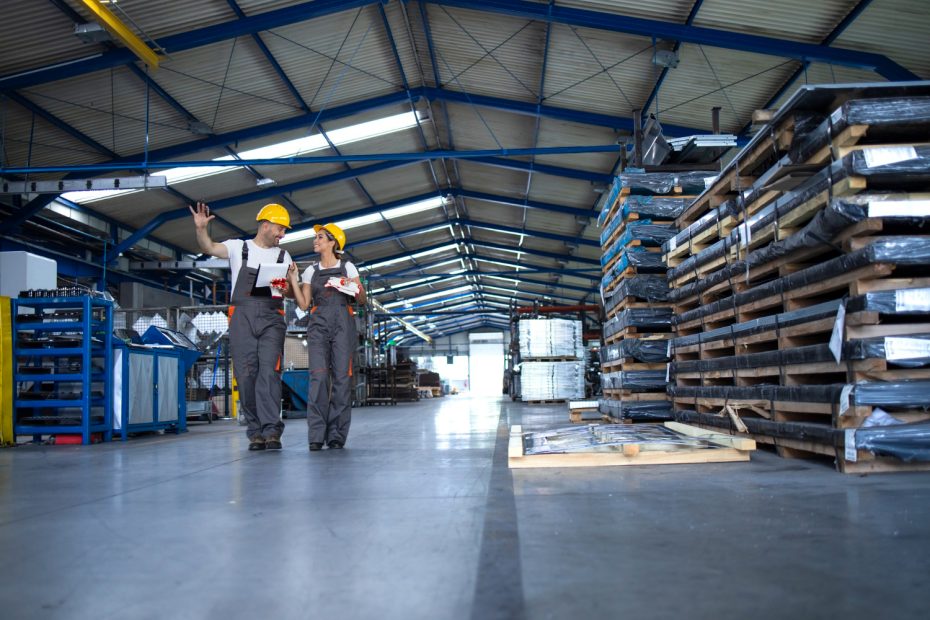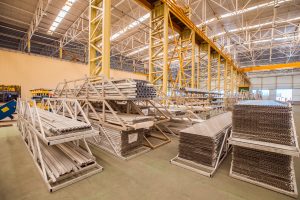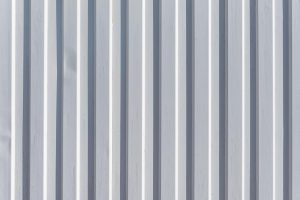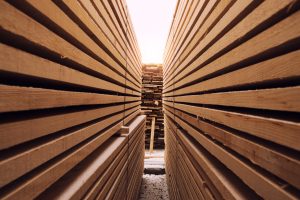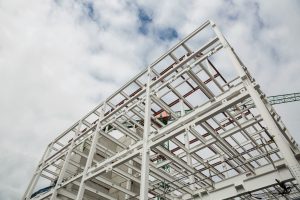In the industrial and logistics world, a warehouse is not just a storage space but an important asset that plays a crucial role in smooth distribution and business continuity. Therefore, choosing building materials for durable warehouse construction is a critical consideration from the very early planning stages.
Many companies still rely on conventional materials without considering long-term efficiency. In fact, by selecting building materials for durable warehouse construction, maintenance costs can be reduced, structural durability increased, and the safety of stored goods better ensured.
This article will discuss in detail various alternative building materials for durable warehouse construction, tips for choosing the right materials, and why investing in high-quality materials is so important.
The Importance of Cchoosing building materials for durable warehouse construction
There are many reasons why selecting building materials for durable warehouse construction is a vital aspect of development:
- Long-Term Structural Durability
Warehouses require a sturdy structure capable of lasting for decades. By choosing building materials for durable warehouse construction, the risk of damage due to extreme weather, humidity, or heavy loads can be minimized.
- Operational Cost Efficiency
High-quality materials reduce the need for frequent maintenance and renovations. This means operational costs can be lowered by using building materials for durable warehouse construction.
- Protection of Stored Goods
Goods in a warehouse must be protected from heat, humidity, and potential fire hazards. Therefore, building materials for durable warehouse construction provide extra protection.
- High-Value Investment
Warehouses built with durable building materials have a higher resale value because their quality ensures longevity and structural strength.
Alternative Building Materials for Durable Warehouse Construction
Here are some of the best building materials for durable warehouse construction, along with their advantages and disadvantages:
1. Light Steel
Light steel is one of the most popular durable building materials for modern warehouse projects. It is known for its high strength despite its lightweight, making it efficient for roof frames and support structures. Light steel is resistant to termites, mold, and corrosion, giving it an edge over wood. Installation is also faster due to its precision and ease of assembly. Although the price is relatively higher, light steel proves to be a durable material with long service life and minimal maintenance.
Advantages:
- Termite- and corrosion-resistant
- Quick and efficient installation
- Strong despite being lightweight
Disadvantages:
- Higher cost compared to wood
- Requires skilled labor
2. Reinforced Concrete
Reinforced concrete is a classic choice that remains relevant for durable warehouse construction. It combines concrete with steel reinforcement, allowing it to withstand heavy loads and high pressure. Its advantages include fire resistance, durability against humidity, and shock resistance, making it ideal for large warehouses needing strong structures. Though construction takes longer and costs more, reinforced concrete provides long-term value with minimal maintenance, making it one of the most popular materials for durable warehouse construction.
Advantages:
- Strong and able to support heavy loads
- Fire-resistant
- Long lifespan
Disadvantages:
- Longer construction process
- Higher construction costs
3. Sandwich Panels
Sandwich panels are widely used in modern warehouses, particularly for walls and roofs. They consist of two metal layers with an insulating core, keeping the interior temperature stable. Their main advantages are energy efficiency, lightweight, and quick installation. Warehouses using sandwich panels save on electricity because cooling systems work less. Although initial costs are higher, sandwich panels are a worthwhile investment for durable warehouse construction, offering excellent thermal and acoustic insulation.
Advantages:
- Efficient temperature control
- Lightweight and easy to install
- Energy-saving
Disadvantages:
- Relatively high initial cost
- Durability decreases if outer layers are damaged
4. High-Quality Processed Wood
Processed wood can still serve as a durable building material if sourced from high-quality types and treated properly. Modern technology allows wood to be made termite- and moisture-resistant, increasing longevity compared to ordinary wood. Processed wood provides a natural aesthetic and is suitable for warehouses with special design needs. Its advantages include shape flexibility and relatively affordable cost, though wood remains flammable and requires combination with other materials. With proper maintenance, processed wood can be a functional and durable material for warehouse construction.
Advantages:
- Provides a natural look
- Can be treated against termites
- Relatively affordable
Disadvantages:
- Flammable
- Requires more intensive maintenance
5. Galvanized Steel
Galvanized steel is ideal for use in humid or coastal areas. Coated with zinc, it resists corrosion and rust. Galvanized steel is strong enough for main warehouse structures, offering long service life and minimal maintenance. However, if the protective zinc layer is scratched, rust may develop. Despite higher initial costs compared to regular steel, the durability and strength make it a worthwhile investment, which is why galvanized steel is a preferred material for durable warehouse construction.
Advantages:
- Rust-resistant
- Long-lasting even in humid areas
- Strong for main structures
Disadvantages:
- More expensive than regular steel
- Prone to rust if protective coating is damaged
6. Aluminium
Aluminium is a durable building material commonly used for roofs, walls, and additional elements in warehouse construction. It is lightweight, rust-resistant, and has a modern appearance, making it a popular choice for contemporary warehouse designs. Other advantages include easy installation and resistance to extreme weather. Aluminium also helps maintain stable interior temperatures due to its reflective properties. Its drawbacks are that it is not as strong as steel and costs more than regular zinc sheets. Nevertheless, aluminium remains an excellent choice for those seeking durable building materials with aesthetic value.
Advantages:
- Lightweight and easy to install
- Rust-resistant
- Modern appearance
Disadvantages:
- More expensive than regular zinc
- Not as strong as steel
7. Lightweight Concrete Blocks (Hebel)
Lightweight concrete blocks, or Hebel, are increasingly popular as durable building materials due to their practicality, light weight, and fast installation. These blocks offer fire resistance, good thermal insulation, and sound dampening. Warehouses using lightweight blocks tend to be cooler and more comfortable. Additionally, the lighter structure reduces foundation load. However, they require special adhesives and proper installation to prevent cracking. With quality workmanship, lightweight concrete blocks are proven as efficient and durable building materials for warehouses.
Advantages:
- Lightweight and easy to install
- Fire-resistant
- Good thermal and acoustic insulation
Disadvantages:
- Requires special adhesive
- Prone to cracking if installed improperly
8. Polycarbonate
Polycarbonate is often used as an additional building material, particularly for roofs or skylights. Its main advantage is transparency, allowing sunlight to enter and saving electricity during the day. Polycarbonate is lightweight, easy to install, and impact-resistant. However, it cannot be used as a primary structural material because it is not as strong as steel or concrete, and its UV resistance is limited. Nevertheless, as an auxiliary element, polycarbonate is a smart choice for energy-efficient and durable warehouse construction.
Advantages:
- Transparent, saving electricity
- Lightweight and easy to install
- Impact-resistant
Disadvantages:
- Not suitable as a primary structural material
- Shorter lifespan than metal
10 Tips for Choosing Building Materials for durable Warehouse Construction
1. Adapt to Climate Conditions
Climate is a crucial factor when selecting durable warehouse construction for warehouses. For areas with high rainfall or extreme humidity, materials such as reinforced concrete or galvanized steel are ideal because they can resist corrosion and moisture. Conversely, in hot regions, using sandwich panels or polycarbonate can help maintain stable indoor temperatures. Choosing materials suited to the climate extends the building’s lifespan and reduces future maintenance costs.
2. Consider the Weight of Stored Goods
The type of goods stored in a warehouse affects the choice of durable warehouse construction . For warehouses storing heavy items like industrial machinery, structural steel and reinforced concrete are more suitable as they can safely support large loads. These materials are not only strong but also long-lasting. For warehouses storing lighter goods, a combination of lightweight blocks and aluminium can be a viable alternative. By considering the load, the warehouse structure becomes stronger, safer, and better aligned with operational needs.
3. Focus on Fire Safety
One important aspect of durable warehouse construction is fire resistance. Fires can cause significant losses, making materials like reinforced concrete, lightweight blocks, and sandwich panels the best options. Concrete withstands high temperatures, while sandwich panels with insulation layers can slow down fire spread. Choosing fire-resistant materials minimizes the risk of damage and ensures stored goods are better protected, providing extra security for the company’s assets.
4. Choose Rust-Resistant Materials
For warehouses near coastal areas or regions with high humidity, selecting rust-resistant materials is essential. Galvanized steel is a top choice, as its zinc coating provides optimal protection against corrosion. This material ensures the building structure remains strong even when exposed to salty air or moisture. Investing in rust-resistant materials reduces long-term repair costs and maintains warehouse performance. The right choice also improves efficiency and extends the building’s lifespan.
5. Prioritize Energy Efficiency
Energy efficiency should also be considered when selecting durable warehouse construction . Using sandwich panels helps maintain stable indoor temperatures, reducing the need for air conditioning. Meanwhile, polycarbonate allows natural light to enter, lowering daytime electricity usage. Energy-efficient materials make warehouse operations more cost-effective and environmentally friendly. Additionally, operational costs are reduced in the long term, making this investment even more worthwhile.
6. Calculate Long-Term Costs
Choosing durable warehouse construction for warehouses is not just about the initial price but also maintenance costs. Materials like reinforced concrete and galvanized steel require a higher upfront investment, but their durability and minimal maintenance make them more cost-effective in the long run. In contrast, cheaper materials may seem advantageous initially but often incur additional repair costs. With careful calculation, you can ensure the warehouse remains durable and efficient without excessive future expenses.
7. Consider the Ventilation System
Good ventilation is essential for maintaining air quality in a warehouse. Therefore, use durable warehouse construction that support proper air circulation. Aluminium and polycarbonate are excellent choices because they are lightweight, durable, and easy to install, aiding ventilation. These materials allow fresh air to flow in, reduce excess humidity, and keep stored goods in optimal condition. Proper ventilation makes the warehouse not only long-lasting but also healthier for workers and safer for storage.
8. Use a Combination of Materials
Do not rely on just one type of material. Combining several durable warehouse construction can produce more optimal results. For example, reinforced concrete can be used for the main foundation, while sandwich panels are applied to walls and roofs to reduce weight and improve efficiency. This combination creates a balance between strength, energy efficiency, and cost. Additionally, the warehouse structure becomes sturdier and more comfortable to use. This approach makes warehouse construction more flexible and adaptable to various business needs.
9. Choose Environmentally Friendly Materials
Beyond durability, environmental considerations are important when selecting materials. Lightweight blocks are eco-friendly due to their efficient and environmentally conscious production process. Similarly, certified processed wood sourced from sustainable forests is a good option. Using environmentally friendly materials not only supports sustainability but also enhances the company’s positive image. These materials remain durable and efficient when used properly, making them a wise choice for modern warehouse construction.
10. Consult Experienced Contractors
Selecting durable warehouse construction should not be done alone without experience. Consulting experienced contractors is crucial to ensure materials are suitable for the warehouse’s needs, location, and budget. Professional contractors can recommend the best combinations for efficiency and durability. Additionally, installation by skilled workers ensures construction quality is guaranteed. This way, you not only achieve a long-lasting warehouse but also minimize the risk of construction errors in the future.
8 Benefits of Using Building Materials for Durable Warehouse Construction
1. Long-Term Durability
Using durable warehouse construction ensures that a warehouse can last for decades. High-quality materials such as reinforced concrete, light steel, or galvanized steel are resistant to extreme weather, humidity, and heavy loads. This durability reduces the risk of structural damage that could disrupt warehouse operations. A long-lasting warehouse also provides business owners with peace of mind, knowing their assets are protected. Therefore, investing in durable warehouse construction is not only about physical strength but also long-term operational stability.
2. Maintenance Cost Efficiency
High-quality building materials reduce the need for routine maintenance. By using durable materials, repair and renovation costs can be significantly minimized. A warehouse that does not deteriorate quickly means business owners do not need to spend extra funds on unnecessary repairs. This maintenance cost efficiency stabilizes operational budgets and minimizes disruptions to logistics activities. Strategically choosing durable materials is a smart approach to long-term financial management.
3. Protection of Stored Goods
Warehouses built with durable materials provide maximum protection for stored items. Fire-resistant, moisture-resistant, and corrosion-resistant materials help keep goods safe. Risks from leaks, excessive heat, or pest attacks are reduced. With a strong structure, warehouse owners can ensure that all valuable assets are protected. This security not only benefits finances but also increases customer and business partner trust in the company’s professionalism.
4. Increased Investment Value
Warehouses constructed with durable materials have higher investment value. Strong, long-lasting properties attract tenants or buyers because their quality is proven over time. Minimal maintenance costs also keep the building’s value stable. Investing in high-quality materials ensures that assets do not quickly lose value. In other words, choosing durable building materials guarantees smooth operations while providing long-term financial benefits for business owners.
5. Supports Energy Efficiency
Some durable materials, such as sandwich panels or polycarbonate, help maintain stable indoor temperatures. This reduces excessive use of air conditioning and lighting, making warehouse operations more energy-efficient. Energy efficiency not only lowers electricity costs but also contributes to environmental sustainability. Materials that are both energy-efficient and durable ensure that the warehouse remains comfortable and fully functional year-round. Selecting durable materials is a smart step toward operational efficiency.
6. Protection from Pests and Termites
High-quality materials like light steel, concrete, or galvanized steel prevent damage from pests, termites, or mold. Using durable materials significantly reduces the risk of structural damage caused by infestations. This is particularly important for warehouses storing food, wood products, or moisture-sensitive goods. Such protection ensures that goods remain safe and the structure intact, allowing warehouse owners to focus on operations without worrying about unexpected damage.
7. Operational Comfort
Warehouses built with durable materials provide a more comfortable working environment for employees. Materials like sandwich panels or polycarbonate help maintain optimal temperature and natural lighting. Strong structures and good ventilation also support proper airflow, reducing excessive humidity. This comfort makes storage, packing, and distribution activities more efficient. Durable materials also minimize disruptions from repairs or damage, keeping warehouse productivity high.
8. Reduced Risk of Production Disruptions
Using durable materials minimizes the risk of production interruptions due to structural damage. A strong warehouse continues to function even under extreme conditions such as heavy rain, strong winds, or heavy loads. This ensures smooth distribution and storage operations without delays. Investing in high-quality materials guarantees operational continuity, reduces downtime, and maintains customer satisfaction. Overall, choosing durable warehouse construction is a key strategy to ensure a productive and efficient business.
Conclusion
Choosing alternative durable warehouse construction is essential to ensure a warehouse is strong, efficient, and a valuable investment. Options include light steel, reinforced concrete, sandwich panels, galvanized steel, aluminium, lightweight blocks, and polycarbonate.
Using durable warehouse construction saves maintenance costs, protects goods, and extends the building’s lifespan.Planning to build a warehouse? Don’t choose materials carelessly! Use durable materials to maximize your investment.
Contact our contractor team today for the best recommendations on durable warehouse construction materials tailored to your business needs.

